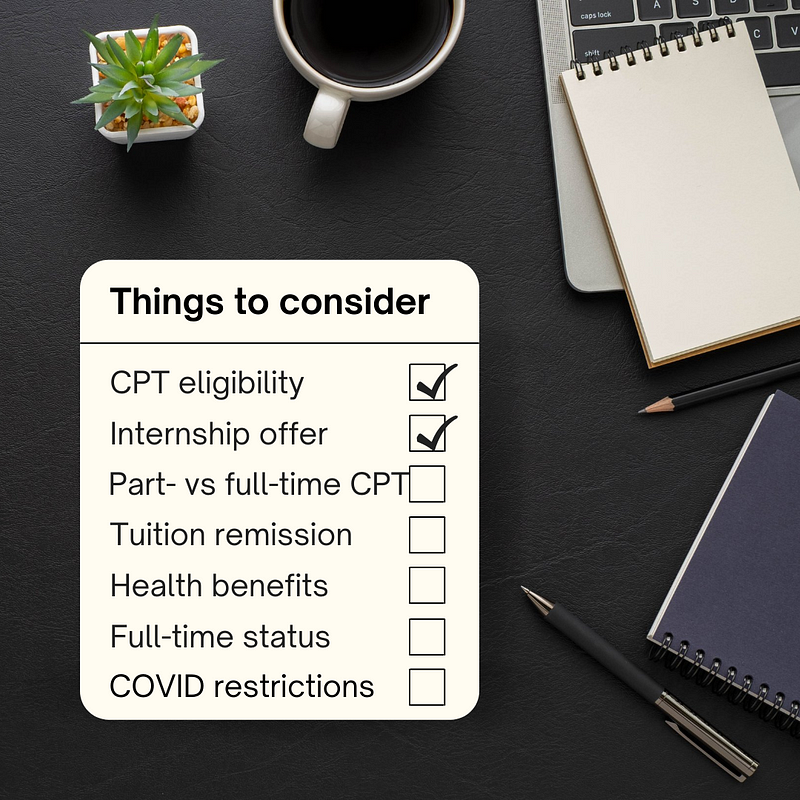An Informal Guide for Ph.D. Interning During the Semester via the F-1 CPT
Published:
If you are reading this article, chances are that you are a Ph.D. student in the U.S. studying on an F-1 visa, and you are considering doing an internship during the Fall/Spring semester and are looking for advice on whether that is: a) possible, and b) feasible and sensible. Since I am not an immigration lawyer, and since this article is not intended to be advice on immigration law, I cannot answer the question of whether interning during the semester is possible or not in your specific case. Generally speaking, though, students on F-1 visas in the U.S. are currently allowed to pursue internship or co-op positions during the summer/winter terms as well as during the Fall/Spring semesters through the Curricular Practical Training (CPT) program.
As it turns out, the ‘possibility’ question is the easier one to answer in most cases. The ‘feasibility’ one is not so simple. (At least, it hasn’t been a walk in the park, in my experience.) If you’re not careful, you might either end up unwittingly violating terms of your research/teaching assistantship (RA/TA) employment or end up having to pay tuition fee out of pocket while also losing health insurance coverage. During the summer of 2021, I interned at a company in the U.S., and the procedure for applying for CPT as well as staying in compliance with other requirements and restrictions was relatively straightforward. When the same company offered for me to come back during the Fall semester, though, I quickly realized that even if CPT rules allowed for me to accept the offer, there were several other things to factor in before making a decision.
Sadly, most relevant resources and guides that I found online — usually on the websites of international students offices of universities — only seem to consider the CPT part of the puzzle but not much else. Figuring out the other parts of the puzzle took me nearly a whole month of emailing/calling different people working in different administrative branches of the university and poring over rule books. I didn’t even know what all I had to consider, and so just when I thought I had accounted for everything, something new popped up and I had to re-evaluate everything. Not to mention COVID-related rules that seemed to change by the week. The entire process left me frustrated, and although I did manage to sign on to the internship eventually, I also lost a whole month’s worth of internship time. Hence my motivation to put together this rough, informal guide with a list of things to consider before you sign that offer letter.
The rules, restrictions and constraints might differ from one person to another and from time to time, and so this is mostly a loose list of things that you may not have already thought about, and not an exhaustive checklist. With that disclaimer out of the way, let’s jump straight in.

Things to consider before signing on to a Fall/Spring internship via the F1-CPT:
1. CPT Eligibility
The question of whether you are eligible to apply for an F-1 CPT during a semester for an internship position that you have been offered is usually easily answered by your university’s international students office. In most cases, though, you should be eligible.
2. Part-time vs full-time CPT
During the summer term, international students on F-1 visas are allowed to be employed outside the university via “full-time” CPT for up to 40 hrs/wk. During the semester, however, students are typically only allowed to be employed for a maximum of 20 hrs/wk including on-campus RA/TA employment.
As a result, if your internship/co-op employer makes you an offer to work for 20 or fewer hrs/wk, you typically qualify for a “part-time” CPT and you’re in compliance with the 20 hrs/wk cap on employment. Full-time CPT for internship employment in the 20-40 hrs/wk range during the semester seems to be allowed only in certain special circumstances (see this handbook by the University of Michigan). I’m not familiar with the pros and cons of doing a full-time CPT during the semester, but in my case, I stuck with the part-time CPT, and for good reasons.
If you are someone that has already done multiple full-time CPT internships, you might want to consider going with the part-time CPT option for your internship during the semester. This is because of the 12 month cap on full-time CPT for eligibility for Optional Practical Training (OPT). (Again, see this handbook.) Part-time CPT currently doesn’t seem to count towards this cap.
3. Tuition remission
Most Ph.D. programs in U.S. universities offer tuition remission to students. What is lesser known, though, is the fact that this tuition remission is usually paid by your TA/RA employer. In other words, if you forego a TA/RA employment for whatever reason, you lose tuition remission!
This means that if you decide to intern during the semester while you’re also registered for credits at the university (irrespective of whether those credits correspond to classes that you registered for or just research credits), you might have to pay for those credits out of pocket. Knowing how expensive tuition credits are in the U.S., it is best to avoid this possibility.
One way to do this is what I did in my case: I signed up for only 10 hrs/wk of internship employment, and the other 10 hrs/wk went towards my RA employment at the university. Do note that the credits for which tuition remission is provided is typically dependent upon the number of hours in your RA/TA employment. If 5 hrs/wk of RA/TA employment might be sufficient to cover the tuition remission you might need, then you might be able to do 15 hrs/wk of internship.
Note that this only applies when you are employed on a part-time CPT. If you instead go the full-time CPT route, you might have to pay full tuition fee out of pocket. Another reason you might want to stick to a part-time CPT.
4. Health insurance coverage
Most internship employers seem to not provide health benefits with their internship offers. I don’t know if this is universally the case, but in my experience, they don’t. If you completely let go of your university RA/TA employment, you will lose access to university-provided health benefits as well.
In my case, because I had other reasons anyway to hold onto my RA appointment, I was able to keep my university-provided health benefits as well. This meant, among other things, that I didn’t have to worry about more paperwork. If you’re looking to take up a part-time CPT internship during a semester for the full 20 hrs/wk (i.e. not retain any hours on your RA/TA employment), you might still have options and resources (like this one) for you to buy health insurance.
5. Full-time student status
F-1 visa rules require international students to meet “full-time student status” requirements at all times during the semesters. I suspect that what constitutes as “full-time student status” might differ from one university to another, but generally speaking, you are required to be registered for a certain minimum number of credits and/or maintain your RA/TA employment.
If you have to forego your RA/TA employment in favor of your internship employment, it is a good idea to double and triple check that you are still meeting the requirements for full-time student status. If you fail to meet these requirements, you might get into a whole lot of trouble related to whether you meet the basic requirements for a valid F-1 status. (Note that this is only a problem during the semesters; during the summer, you do not need to meet the same constraints to be considered a full-time student.)
6. COVID-related restrictions
As if this isn’t complicated enough already, additional temporary rules brought about by the pandemic mean that international students must be extra-careful before accepting any internship offers, be it during the summer or during the semesters. Some questions to ask upfront are:
- Do current CPT rules (including any COVID-related temporary restrictions) allow me to be employed for in-person work with a non-university employer?
- If so, does that mean that in-person work with employers located anywhere in the U.S. is allowed? Or is the allowance only made if the location of work is in the same state or area as the university?
- If you set up an arrangement for interning during the semester that is, say, 10 hrs/wk in-person internship work and 10 hrs/wk RA/TA work, then you likely will be doing your RA/TA work remotely. Does the grant/funding source of your RA/TA employment allow for you to work remotely?
A final note
In most cases, internships are best done during the summer months when you don’t have to worry about classes or other constraints. During the semester, there’s so many more things to consider before signing on to that offer letter, and that is especially so for international students on an F-1 visa. While the complexity of this entire process and the lack of official guidebooks that cover all aspects of it frustrate me, I am nonetheless grateful that interning during the semester is even allowed for international students.
Following a very memorable and fun summer interning at Bell Labs in 2021, when they made me an offer to extend to the Fall semester, I didn’t hesitate at first. But when I gave them an informal “yes”, I realized that I had stepped onto a minefield, and one wrong step could have me in trouble. I was lucky in that my Ph.D. advisor was supportive all along and helped me through this complicated mess of a process. Figuring out the details still took me a month or so, but in the end, it was worth it, and I got to go back to a place that I’ve loved working at for 10 more weeks. I wouldn’t blame you if you’re discouraged by how complicated the process of getting all approvals and checking all the boxes can be, but I hope that this super informal guide can help you alleviate some of that frustration by giving you a non-exhaustive list of things to watch out for. And I hope that your interning-during-the-semester adventure will be as fun and worthwhile as mine was!

This story was originally published by the author on Medium.
